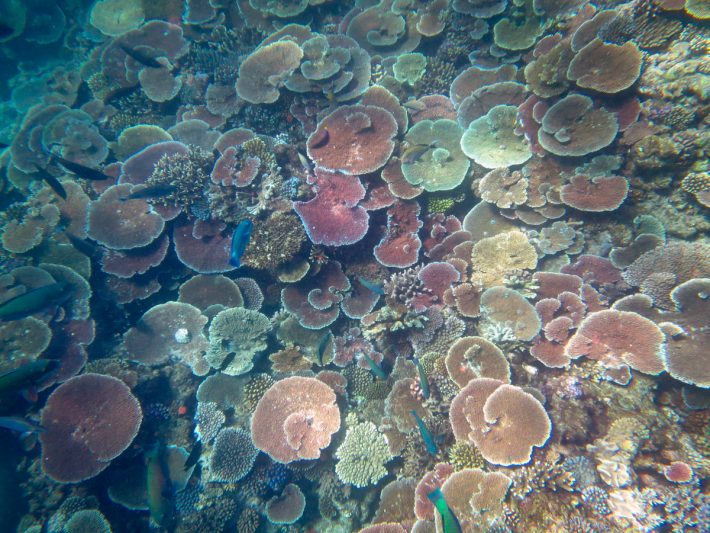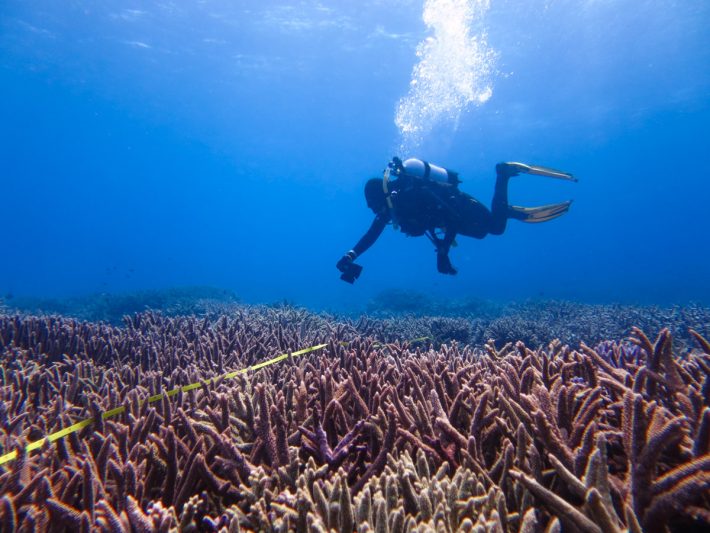A reef in two gears: new patterns of coral recovery discovered
QUT press release.
Damaged coral reefs show slower than expected recovery for up to six years before switching to a faster phase of regrowth, according to new research published in the Journal of Applied Ecology.

This ‘two-phase’ recovery pattern was observed in 60 per cent of severely disturbed reefs on the Great Barrier Reef.
The modelling research, involving scientists from QUT and the Australian Institute of Marine Sciences (AIMS), pinpoints patterns of reef recovery amid disturbances including storms, marine heatwaves, and crown-of-thorns starfish.
The researchers mapped the presence of the ‘two-phase pattern’ in reef recovery based on AIMS long term monitoring data by modifying data analysis methods used in cancer cell biology.
The findings have been published in the Journal of Applied Ecology (October 28 05:01 UK time).
Lead researcher, Dr David Warne, from QUT’s Centre for Data Science, said it was a “serendipitous moment in science” that brought together the team involving mathematicians, statisticians, and marine ecologists.
Dr Warne said the connection between reef research and cancer research stemmed from a seminar at the ARC Centre of Excellence for Mathematical and Statistical Frontiers (ACEMS) with AIMS senior scientist, Dr Juan Ortiz, providing insights into growth patterns of Tabular Acropora.
“The actual growth dynamics of individual coral colonies is vastly different to cancer cells, but the net population level behaviour can be remarkably similar,” Dr Warne said.
It’s like starting your car in the wrong gear, you move really slowly until the engine catches up and then you move normally
Dr Warne said the results of the research provided critical information for the management of the GBR as it identified reefs in need of help, in the same way doctors triage patients to prioritise treatment.
“There was a working assumption that main driver of reef recovery was competition for space, but these results suggest that corals colonies may be growing at lower rates for three-to-four years after major disturbances.”
The researchers also found the two-phase recovery pattern was present in 50-60 per cent of the monitored sites that had experienced at least one major disturbance over the past 30 years.
Dr Ortiz said the research provided detailed insights into the coral growth currently being observed in the field on the Great Barrier Reef.
“It’s like starting your car in the wrong gear, you move really slowly until the engine catches up and then you move normally,” Dr Ortiz said.
“Since 2009, the GBR has been hit hard with mass bleaching events, cyclones, and crown-of-thorns starfish outbreaks, reducing coral cover.
“After a window of reprieve from disturbances, AIMS’ Long-Term Monitoring team has recently observed strong increases in coral cover.
“We can see those reefs which have experienced rapid increases are now in the second, faster recovery phase.”

Dr Warne said the research emphasised the importance of future studies to understand mechanisms driving the two-phase patterns of coral growth.
The research team involved AIMS’ Dr Ortiz, Kerryn Crossman, Kate Osbourne and Angus Thompson, Wang Jin from the University of NSW as well as QUT’s Dr Warne, Distinguished Professor Kerrie Mengersen, Professor Matthew Simpson, and Dr Paul Wu who are also members of ACEMS.
You can the full article for free (for a limited time) here:
, , , , , , , , & (2021). Identification of two-phase recovery for interpretation of coral reef monitoring data. Journal of Applied Ecology, 00, 1– 12. https://doi.org/10.1111/1365-2664.14039
Like what we stand for?
Support our mission and help develop the next generation of ecologists by donating to the British Ecological Society.